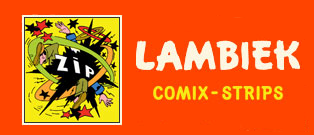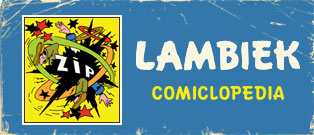Comics History
Pilote (1959-1989)
The francophone comics magazines of the mid-20th century got big competition in 1959. On 29 October of that year, the first issue of Pilote was published. The magazine was an initiative of comics writers, René Goscinny and Jean-Michel Charlier, artist Albert Uderzo and Jean Hébrard. In the years before the launch of Pilote, the team founded the Édipresse and Édifrance agencies. They put out Le Supplément Illustré, a supplement for the daily press. They continued to work for Radio-Télé, a magazine of Radio-Luxembourg. But soon, the idea for a magazine of their own came up and Pilote was a fact. Promoted by Radio-Luxembourg, the 300,000 copies of the magazine's first issue were sold out in one day.


Since Charlier and Goscinny were founding fathers of the magazine, they took on most of the initial writing. Already in the first issue, Charlier came up with two popular series, 'Tanguy et Laverdure' with Albert Uderzo and 'Barbe-Rouge' with Victor Hubinon, but also 'Jacques le Gall' with MiTacq. The artwork of both 'Tanguy' and 'Barbe-Rouge' was later taken over by Jijé. Goscinny took on 'Le Petit Nicolas' with Jean-Jacques Sempé and his biggest hit ever: 'Astérix' with Uderzo. Other early artists were Raymond Poïvet, who drew 'Mark Trent' and Christian Godard, who illustrated Goscinny's 'Jacquot le Mousse'. The editorial pages were filled by celebrated radio personalities of the time.



The magazine's future was in danger in 1960, when financial problems caused the investors to back out. Fortunately Dargaud publishers came to the rescue and published the magazine from then on. With their new publisher, the magazine expanded. New series were launched, such as 'Guy Lebleu' (by Poïvet and Charlier), 'Valentin le Vagabond' (by Jean Tabary and Goscinny), 'Tracassin' (by Jean Chakir), 'Duduche' (by Cabu), 'Tony Laflamme' (by Martial) and 'Norbert et Kari' (by Godard). The longrunning 'Bob Morane' series, based on the novels by Henri Vernes, was continued in Pilote from 1962. Several artists had their turn on the comic, such as Claude Pascal, Gérald Forton and William Vance. Other notable appearances are the western 'Blueberry', conceived by Jean-Michel Charlier and Jean Giraud in 1963, the transfer of Morris's 'Lucky Luke' from Spirou to Pilote in 1968, and the first appearance of Michel Greg's 'Achille Tallon' in 1963.

Through Dargaud, Pilote could acquire several comics from the British Hulton Press agency. Series from the British Eagle magazine found their way to Pilote, like 'Jeff Arnold' (Charles Chilton and Frank Humphris), 'Fraser l'Africain' (George Beardmore and Frank Bellamy) and 'Winston Churchill' (Clifford Makins and Frank Bellamy). Radio-Luxembourg was still involved with the magazine and provided several editorial pages. In 1963, Obélix's dog Idéfix got his name through a readers contest. Young, innovating artists joined the magazine's ranks in the late 1960s, such as Marcel Gotlib ('La Rubrique à Brac'), Claire Bretécher ('Cellulite'), Alexis ('Timoléon'), Nikita Mandryka ('Les Clopinettes'), Jean-Marc Reiser and Jacques Lob. Pierre Christin and Jean-Claude Mézières launched the science-fiction series 'Valérian'.


The early 1970s called in a crisis period for Pilote. For several artists, Pilote wasn't the place to further exploit their dark and more adult humor. After disputes with editor-in-chief René Goscinny, Gébé, Cabu and Reiser moved over to Hara-Kiri and Charlie Hebdo, while Gotlib, Bretécher and Mandryka launched a magazine of their own, L'Écho des Savanes. In order to cope with this deflate, Pilote turns from weekly to monthly magazine in June 1974. Guy Vidal replaced René Goscinny as editor-in-chief and tried to repair the damage. Loyal artists continued their work to the magazine, such as Fred ('Philémon'), F'Murr, Bilal, Pétillon and Caza. Among the new artists were Michel Blanc-Dumont and Laurence Harlé, with their 'Jonathan Cartland' series.

Also, Gérard Lauzier, Annie Goetzinger, François Thomas, Régis Franc and Max Cabanes made their appearance. Jean-Pierre Gourmelen and Antonio Palacios started the successful 'Alexis McCoy' series, François Rivière and Jean-Claude Floc'h began 'Albany' and Julio Ribera took on 'Le Vagabond des Limbes'. Work by foreign artists such as Hugo Pratt and Robert Crumb was also published.
Pilote's sales augmented again, and several specials appeared. However, sales began to decline again in 1980, despite the arrival of new talented artists like Martin Veyron, Baru, Philippe Bertrand and Alain Bignon. Pilote merged with Charlie Mensuel in 1986 and continued under the name Pilote et Charlie until 1988, when the name was changed to Pilote again.
New artists of the time were Denis Frémond, Joseph Béhé, Luc Cornillon and Philippe Francq. The magazine also contained foreign work by Horacio Altuna, Manfred Sommer, Alfonso Font, Paolo Eleuteri Serpieri, Franco Saudelli, Walter Fahrer and Rodolfo Torti. However, Pilote also became victim of the decline of interest in comics magazines, and the final issue appeared in November 1989.





